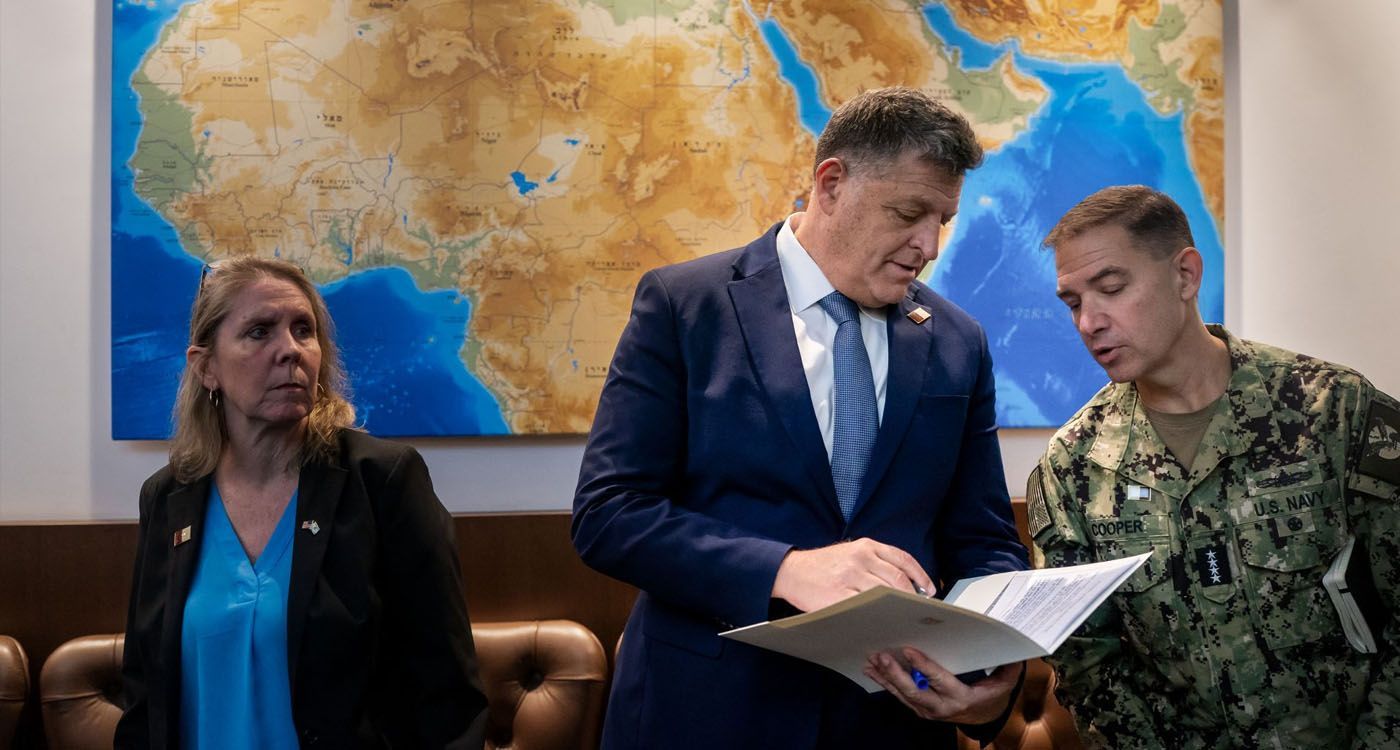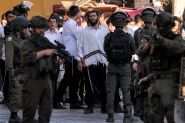- Home
- Middle East
- The CCMC: A New International Coordination Hub for Gaza

The CENTCOM commander, Admiral Brad Cooper (right), speaks with Ofir Falk, diplomatic adviser to the Israeli Prime Minister, before the meeting between the U.S. Vice President and the Israeli Prime Minister in Jerusalem on October 22, 2025. ©Nathan Howard / AFP
The Civil-Military Coordination Center (CMCC), based in Kiryat Gat, Israel, has become the most visible symbol of international involvement in Gaza’s postwar phase.
Inaugurated in mid-October 2025, it was established by the United States as part of Washington’s peace plan to oversee humanitarian aid, reconstruction, and compliance with the ceasefire.
According to an official statement from U.S. Central Command (CENTCOM) released on October 21, “the CMCC is designed to support stabilization efforts. U.S. military personnel will not be deployed inside Gaza but will facilitate the flow of humanitarian, logistical, and security assistance to the enclave.”
Around 200 U.S. service members specializing in transport, planning, and engineering set up the center under the leadership of Lieutenant General Patrick Frank.
An International Mission Under U.S. Command
According to Yedioth Ahronoth, the base is overseen by U.S. Lieutenant General Patrick Frank, with former U.S. Ambassador to Yemen Steve Fagin serving as the State Department’s civil-military coordination officer.
U.S. Secretary of State Marco Rubio, who visited the site last Friday alongside Israeli General Yaki Dolf, described the initiative as a “historic mission,” stressing that “aid must be delivered without diversion, and stabilization force established before any major reconstruction effort begins.”
Alongside Israeli personnel, the center hosts contingents from France, Spain, Germany, the United Kingdom, Australia, Greece, Jordan, and the United Arab Emirates, as well as representatives from the ICRC and humanitarian organizations.
Also, according to Yedioth Ahronoth, two large posters displaying Donald Trump’s 20-point plan for Gaza hang in the operations room, where screens continuously broadcast footage of convoys and real-time reports on food, water, and medical supply needs.
An American Presence Transforming Kiryat Gat
In the streets of Kiryat Gat, this new reality has not gone unnoticed. The Jerusalem Post describes American soldiers “in camouflage uniforms, walking between shawarma stands and sports shops,” now part of the local landscape. Cafés and restaurants are reportedly “working around the clock” to feed newcomers.
Mayor Kfir Swisa said the city welcomed the foreign personnel “with open arms,” viewing the facility as both a “security and economic asset.” But some residents fear the CMCC’s presence could make Kiryat Gat a strategic target for Hamas, Iran, or the Houthis. The Jerusalem Post notes that on social media, some even refer to it as part of a “new world order,” reflecting broader anxieties about America’s expanding role.
A Murky Mandate and Israeli Criticism
For Israeli authorities, the CMCC’s arrival is a double-edged turning point: a useful coordination tool, but also a potential source of constraints. Daily Israel Hayom notes that “the center remains unclear about how it will help Israel achieve its core objectives in Gaza,” particularly demilitarizing Hamas and curbing arms smuggling.
There are growing concerns that the international mechanism could limit the Israeli army’s operational freedom and push Israel toward diplomatic consultation over preventive military action. Likud MP, Amit Halevi, called on the Knesset to set up a dedicated parliamentary oversight mechanism to ensure that the CMCC’s secrecy does not serve as a “cover” for activities undermining national security.
The Dilemma of Reconstruction and Disarmament
As the international framework takes shape, Hamas continues to consolidate its power in Gaza. Leader Khalil al-Hayya reaffirmed that the movement would not relinquish its weapons “as long as the occupation persists.”
This stance, repeatedly stated, undermines prospects for real demilitarization which is the core of the U.S. plan.
The CMCC, tasked with monitoring the ceasefire and coordinating aid delivery, thus risks becoming more of a management mechanism than an instrument of transformation: an observation post without real coercive leverage on the ground.
A Symbol of the Limits of International Involvement
The CMCC embodies the new internationalization of the Gaza issue. As Yedioth Ahronoth put it, “the Americans lead, the allies follow, and Israel hosts.”
While it may help streamline humanitarian logistics and ensure aid transparency, its effectiveness will depend on the clarity of its mandate and the ability of participating powers to balance security, governance, and reconstruction.
As long as these balances remain fragile, the Kiryat Gat facility will stand less as a peace instrument than a laboratory of tensions between Israeli sovereignty and multilateral conflict management.
Read more





Comments